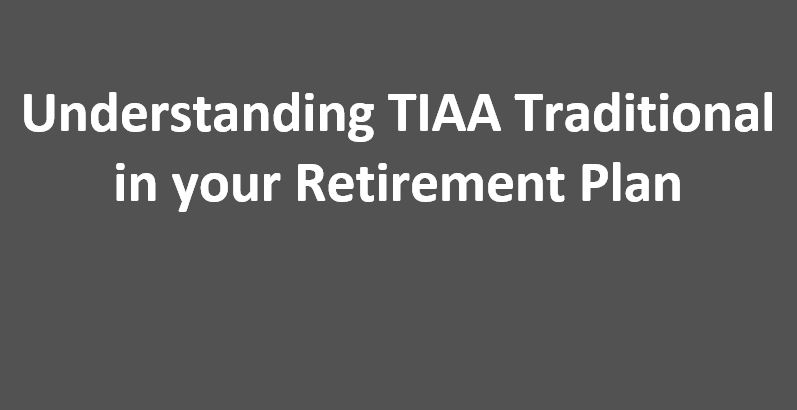If you’re fortunate enough to have a retirement plan through your employer managed by TIAA, your plan will have access to the TIAA Traditional Annuity option. This is a unique guaranteed investment option only available from TIAA.
Client interest in this guaranteed option is on the rise as the yields on short term bond funds have gone down to practically nothing, and the prospect of rising interest rates is causing fear that bond funds will lose value in the short term.
If you have been confused about the TIAA Traditional option in the past, you’re not alone. In this post I’m going to clear up some of the confusion around this unique investment option.
TIAA calls the period in which you are employed and making contributions to your retirement plan the “accumulation period”. There are other rules that determine how assets can be paid out or annuitized during the “payout” phase, but in this first post I will focus on the accumulation period.
The Traditional account is guaranteed at 3%, and can never decrease in value. In that sense it is like a stable value investment option. The interest rate, currently 3% or greater, is also higher than a typical short term bond fund. Unlike a stable value fund, the interest rate will also move higher as interest rates go up. There is also an additional crediting of interest in excess of the guaranteed rate declared by TIAA on a year to year basis.
With a guaranteed principal (what you contribute will never go down) and a guaranteed rate of interest, it’s a great candidate for some of your fixed income allocation. So while not a bond fund, it is sensible to think of TIAA Traditional as part of your fixed income allocation in your portfolio. The downside is that you do lose some of your flexibility when it comes to rebalancing.
You receive a higher interest rate because of the restrictions around withdrawals. This makes sense because it allows TIAA to invest for the long-term at higher rates if you also commit to long-term investing.
That is why it should only take up a portion of your fixed income allocation. I recommend to clients that have TIAA traditional available and are conservative investors to consider allocating somewhere between 25% to 50% of their fixed income allocation to TIAA Traditional. For example, younger investors with a 20% total allocation to fixed income might want to consider allocating 5% of their portfolio to TIAA Traditional (equivalent to 25% of their total fixed income allocation of 20%). Investors closer to retirement with a 40% allocation to fixed income may want to consider allocating 10%-20% of their total portfolio to traditional.
Next, let’s take a look at a typical university retirement plan which consists of a 401(a) account and a voluntary 403(b) account. There are two types of contracts: GRA/RA contracts and GSRA/SRA contracts.
As of late 2016, the GRA/RA contract is paying 3.75%. The higher rate comes with a tradeoff which is a restriction on transfer or withdrawals out of the account. There is a 10-year withdrawal period on transfers out of the account, which allows transfer out in 10 installments over 9 years and 1 day.
The GSRA/SRA contract is currently paying 3%. GSRA stands for Group Supplemental Retirement Annuity and would typically be found in a 403(b). If you have this option, the good news is that there are no restrictions on transfers or withdrawals. In exchange for the liquidity, the contract pays less, 3% at the moment, which is the guaranteed rate. The good news of course is that if interest rates rise so will the accumulation rate.
So if you have access to both types of contracts the GSRA/SRA is your best choice if you want more flexibility on transfers out of the account for rebalancing.
If on the other hand you are closer to retirement and have a larger fixed income allocation in your portfolio with plenty of room in your other bond funds for rebalancing, you should consider using the GRA/RA option for the higher crediting rate. It will provide an excellent foundation for retirement income.
If you’re someone who has already made contributions to TIAA Traditional in your plan over the years without knowing which type of contract you have, you will have different amounts invested at various interest rates. These are called “vintages”. The most important thing to know is that older “vintages” of contributions are much more valuable than recent contributions. Depending on when you add to traditional the crediting rate that is in effect at that time applies to that contribution. For example, pre-2000 contributions in GRA/RA contracts are paying 4.75% or more.
To determine what vintages and type of contract (either GRA/GSRA) you own, look online at your account details by “Asset Class” for “Guaranteed Investments”. You should see a link next to TIAA Traditional called “View Interest Rates” to drill down and view the details of your various vintages.
[Related Reading: Why You Need Real Financial Planning]


